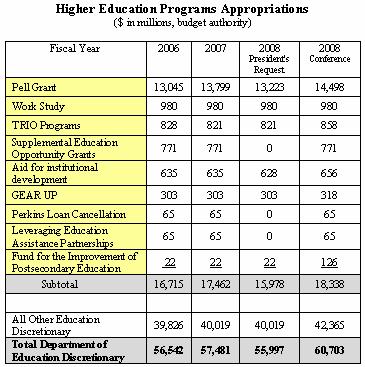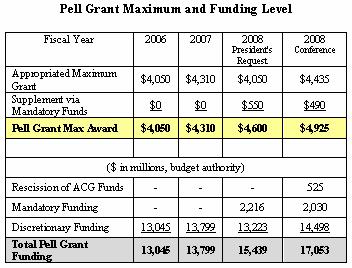A Good Year for Pell Grants, A Great Year for Earmarks
Blog Post
Nov. 28, 2007

After passing a $150.8 billion conference agreement on the fiscal year 2008 Labor-H appropriations bill, Congress sent the bill to the President on November 8th. He vetoed it on the 14th, arguing that it included at least $9 billion more in spending (plus another $2 billion in advance appropriations) than he had requested. Two days later, the House failed by two votes to override the veto. That is where the bill stands now, and it is where Congress will have to pick up when it returns next week.
While it is impossible to predict what the final outcome will be for the fiscal year 2008 education funding bill, it is worth highlighting the higher education funding included in the conference agreement. The table below summarizes fiscal year 2006, 2007 and proposed 2008 funding for all of the higher education programs that receive funding through the annual appropriations process. In the Labor-H conference agreement sent to the President, the two biggest higher education winners, both in percentage and absolute dollar terms, are the Fund for the Improvement of Postsecondary Education (FIPSE) and the Pell Grant program.
FIPSE (Earmarks)
The largest increase for all higher education programs in percentage terms (and second largest in absolute terms) goes to FIPSE. This program is treated as an earmark slush-fund in the Labor-H appropriations bill, because FIPSEs mandate is broad enough that any earmark that a Member of Congress, lobbyist, or university could dream up for higher education qualifies. Members of Congress submit requests to the appropriations committee for a slug of the money, and this year, theres a lot more money to bring home.
For the past two fiscal years, Congress provided $22 million for FIPSE. The proposed Labor-H appropriations conference agreement provides $126 million, nearly a five-fold increase. Its worth a chuckle to note that the House proposed $63 million and the Senate proposed $82 million for FIPSE, but the "compromise" included in the conference was $126 million. The $100 million-plus increase in FIPSE for earmarks could probably be better used on grant aid provided directly to needy students say by providing a $100 million increase in the Supplemental Education Opportunity Grants, which are flat-funded in the conference agreement. A complete list of the FIPSE earmarks is available at this link.
Not that all earmarks are bad, but it certainly is difficult to tell if all (or any) of the earmarks on the 14 page list would be a good use of taxpayer funds and provide a meaningful benefit to schools and students. Of course, this is precisely the problem with earmarks. The public is unable to access much information about an earmark proposal, and therefore is unable to hold Congress accountable.
The Pell Grant Increase
Under the conference agreement the Pell Grant program would receive $14.5 billion, a $699 million (5.1 percent) increase from the prior year. Before mandatory funds supplied by the recently enacted College Cost Reduction Act are added to the mix, that translates into a maximum Pell Grant level of $4,435 for the 2008-2009 academic year. In other words, absent new mandatory funds for Pell students, under Congress' discretionary funding bill, the maximum grant would be $125 dollars higher than the year before. It is interesting to note that the increase is less than the increase provided last year, which was $260, when the maximum grant was raised from $4,050 in 2006 to $4,310 for 2007.
It is surprising that in the first budget and appropriations cycle conducted by the new Democratic majority in Congress, a discretionary funding Pell Grant increase of only a $125 is proposed. To be sure, new mandatory funds will be provided to boost the Pell Grant by another $490, bringing the maximum grant to $4,925 for fiscal year 2008. Could it be that the Congress did not feel the need to increase the Pell Grant on the discretionary budget side (i.e. in the Appropriations bill) by any more than $125, because it took into account the new $490 supplement that would be provided through mandatory funding? In other words, is the new Pell Grant funding that was made available by cutting excessive spending on subsidies for student lenders supplanting what would have been provided through the appropriations process? The smaller-than-expected $125 increase certainly makes it look that way. If any supplanted funding is going to a good cause, we can't quibble. The problem is we, and you, don't know.
